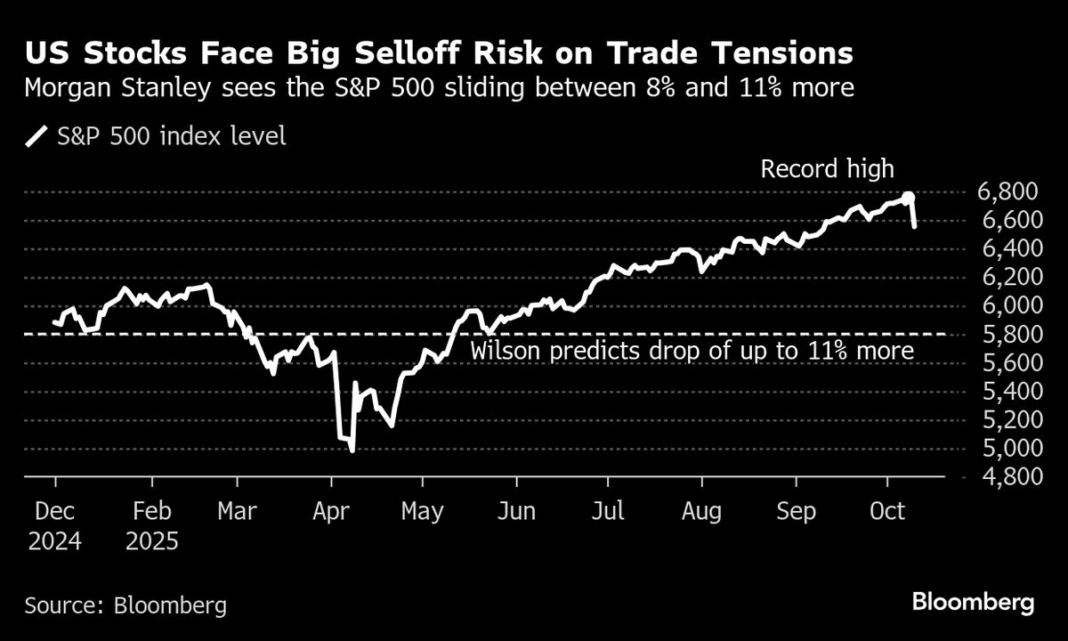Understanding the Current Market Climate
The recent commentary from Morgan Stanley’s Chief U.S. Equity Strategist, Michael Wilson, has sent ripples across the financial landscape, warning that U.S. stocks could plunge by as much as 11%. This potential downturn is intricately linked to the escalating trade tensions between the U.S. and China, a situation that demands attention as the November deadline looms. In this article, we’ll unpack the implications of Wilson’s predictions and the broader context driving these sentiments.
The Stakes of Trade Tensions
Trade relations between the U.S. and China have long been a point of contention. Disputes over tariffs, technology transfers, and market access have periodically strained this critical relationship. Wilson’s assertion underscores a key concern: when trade tensions escalate, it is often the stock market that bears the brunt of the fallout. Investors understand that instability in trade can lead to supply chain disruptions, increased costs for companies, and ultimately, lower profits—all factors that can depress stock prices.
The Impact on Investor Sentiment
Market psychology plays a pivotal role in stock market dynamics. Fear and uncertainty are formidable adversaries that can cloud judgment and lead to a sell-off. Wilson believes that if a resolution between the two economic giants isn’t reached soon, investor confidence could wane significantly. This decline in sentiment can trigger a vicious cycle; as stocks drop, more investors may panic, leading to further sell-offs, thus exacerbating the downturn.
Sector-Specific Vulnerabilities
Not all sectors react similarly to trade tensions. The technology sector, for instance, is particularly vulnerable due to its heavy reliance on global supply chains and international sales. Companies such as Apple and Qualcomm depend on China not just for manufacturing but also for a significant segment of their customer base. A downturn from escalating trade tensions could be disproportionately detrimental to these firms, leading to stock price declines that far exceed the broader market averages.
The Role of Economic Indicators
Investors are keenly attuned to economic indicators when assessing risks. Inflation rates, employment figures, and consumer confidence can all signal how resilient the economy is in the face of potential unrest. If trade tensions worsen, these indicators might begin to reflect the strain in the economy, further justifying Wilson’s prediction of an 11% decline. Economic fundamentals often provide a clearer picture of market direction and serve as essential guidance for investors.
The Possibility of Diplomatic Resolution
Despite the grim outlook, there exists a glimmer of hope in diplomatic resolutions. Continued negotiations and communication can alleviate some tensions and stave off drastic market repercussions. If the U.S. and China can come to a consensus by the deadline, it might not only modify sentiment but could also restore investor confidence, potentially stabilizing or even rallying the stock market.
Historical Context of Trade Wars
The context of historical trade wars provides valuable lessons in understanding the current landscape. Previous bouts of trade disputes, such as those between the U.S. and the European Union, have shown that prolonged tensions can lead to significant market corrections. Historical data can serve as a guiding light for investors trying to navigate the current uncertainty, revealing patterns in stock movements relative to trade announcements and political decisions.
The Global Economic Ripple Effect
Trade tensions are not merely a bilateral issue—global markets are intertwined. If the U.S. and China enter into a prolonged trade conflict, the ramifications could reach far beyond their borders. Emerging markets, particularly those closely tied to Chinese manufacturing and exports, may experience downturns that could, in turn, affect the U.S. economy. This global interconnectedness is a compelling reason for investors to keep a watchful eye on the evolving situation.
The Investor’s Playbook
What should investors do in light of these warnings from Wilson? Diversification becomes crucial. Investors may want to reassess their portfolios to mitigate risks associated with sectors most vulnerable to trade issues. Consideration of defensive stocks—those likely to perform well regardless of economic downturn—can also serve as a hedge against potential volatility. Additionally, staying informed about trade discussions and their potential impacts will be vital in making proactive investment decisions.
Conclusion
While Wilson’s prediction may sound alarming, it encapsulates the volatile interplay of trade relations and stock market dynamics. Understanding the breadth of factors at play, from investor psychology to sector vulnerabilities, equips investors to navigate this uncertain landscape with informed caution. As we approach the November deadline, staying alert and adaptable will be key strategies for anyone invested in the market.



